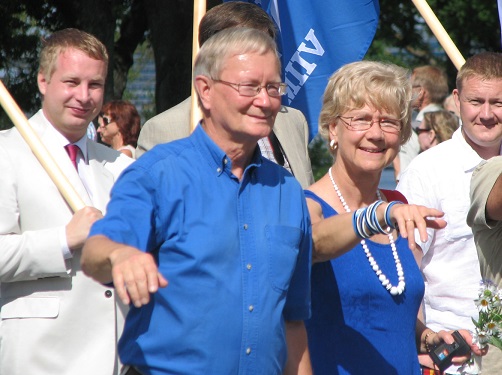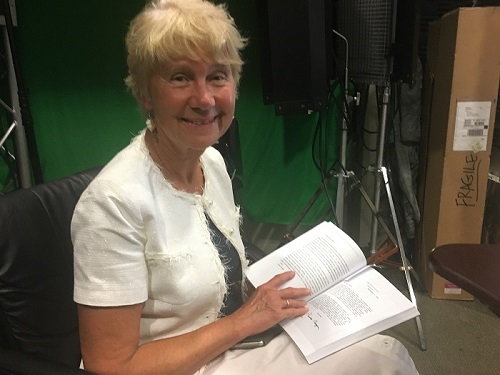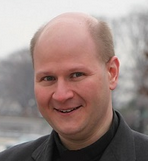
WHEATON, IL—When I asked Mari-Ann Kelam about the seven-hour delay she endured on an airport runway coming to speak at an Acton Institute event at Wheaton College, she evinced no hint of irritation. “There are worse places we could be,” she answered demurely.
Kelam – immaculately poised, a rare combination of grace and dignity that eschews the spotlight – seemed to prefer discussing her family’s journey from despotism to freedom. Her parents fled Tallinn, the capital of Soviet-occupied Estonia, in September 1944 on “one of the last ships to get out.” When her parents fled her homeland, they took little besides a Phillips radio, which “saved them on many occasions, because they could follow the news.” Her parents emigrated to Czechoslovakia, then to U.S.-controlled West Germany, where Mari-Ann was born. Under the terms of the Displaced Persons Act, her family settled in Bellevue, Ohio, a small town near Lake Erie.
“Their reaction to America was, ‘Wow, there are so many churches here.’ The small town of Bellevue must have had a dozen churches for 8,000 people,” said Kelam, a practicing Lutheran.
Faith soothed the pain inflicted by earthly doubt. “The biggest challenge was not knowing what had happened to your family,” she said. Her maternal grandmother opted not to join them on the boat out of Tallinn, promising to follow shortly. The Soviets bombed the next ship – a boat full of refugees – leaving her family to assume the worst. Only after Stalin’s death in 1953 did a letter come, forwarded through a variety of intermediary destinations, telling the family that her grandmother remained alive.
Her mother began speaking at every function she could find – Rotary Club meetings, civic meetings, church events – about the reality of life in the Union of Soviet Socialist Republics. “She felt she had a duty to warn the American people how easily you can lose your freedom,” Kelam said. Estonia had lost its freedom in a deal between two of the twentieth century’s greatest madmen.
Between two totalitarianisms
The colonial ideologies of Nazism and Communism divided Eastern Europe between themselves on August 23, 1939, with the Molotov-Ribbentrop Pact. Stalin’s Soviet Union occupied Estonia, only to be displaced by Nazi invaders in 1941. During their initial occupation, the Soviets deported more than 10,000 Estonians to Siberia. When the Soviets returned in 1944, the mass deportations resumed – with ferocity. The newly unveiled monument to the Estonians who died in Siberian exile records the names of the 22,000 victims known so far – excluding those who died in occupied Estonia, survived captivity, or faded into the anonymity of mass atrocities.
Soon, young Mari-Ann followed her mother’s footsteps. As a teenager, she rallied attendees at Girls State against communist expansionism. As an adult, she kicked off a lobbying and publicity effort ambitious by today’s standards – much less those of the pre-internet era, when submissions had to get past mainstream media gatekeepers. She wrote letters to the editor as often as possible. She altered her voice to call into radio talk shows more frequently. She wrote tirelessly, under her own name and pseudonymously. “Once, The Washington Times had a Baltic focus and published six letters to the editor on the topic,” she said. “Five of them were by me,” under various names.
She organized protests against every Soviet human rights violation – once having a face-to-face meeting with the Soviet Minister of Foreign Affairs, Eduard Shevardnadze, in the middle of a street on Washington’s Embassy Row. After each coordinated event, Kelam went just a bit further, something she calls “doing the last five percent.”
“The last five percent for me has been extremely important,” Kelam told me. “After you have a successful demonstration, everybody goes out and has a beer – and Mari-Ann goes to the phone booth and calls the Associated Press and asks, ‘Why weren’t you there covering this?’ And as a result, she gets an article in the paper, which wouldn’t have happened without the last five percent.”
In another instance, Ted Koppel’s TV show “Nightline” invited members of the Baltic community to be part of the background. “There was a woman going through the audience asking if anyone had a question,” Kelam said. “They called all the people [who wanted] to speak in a long line, and I was near the end.” As the clock ticked down to the end of the show, “the people ahead of me all sat down. I kept standing, and he ran the show over, which is unusual for American television. And I got my question” about the Soviet domination of Estonia – merely because she had been the one person not to give up. Protest after protest, phone call after phone call, letter after letter, one lobbying meeting after another, she just kept going.
“God was with me, that’s all I can say,” she said, looking into the distance. “So many times I pray before I have these events.” And when discouragement threatened to overwhelm her, strength cascaded into her life unexpectedly.
Sincerely, Ronald Reagan
“My mother inspired me, and then, in 1983, I was inspired from the highest levels,” she said. After one of her regular letters to the president, she received a green envelope with the return address marked “White House.” With trembling hands, she opened the signed letter dated September 6, 1983, which read:
I was deeply touched by your letter. You exemplify one of the deepest reasons why America has succeeded as a nation: people came here from every land under the sun and they discovered a country which enabled them to prosper, which inspired their loyalty – and yet never asked them to renounce their own sense of cultural identity and ethnicity. On the contrary, the fabric of American life is like a rich tapestry woven from many strands of different textures and colors – unified by a common respect for our free institutions based on the dignity of every person as a child of God.
Too often, sadly, we Americans take our freedom for granted like the air we breathe. We do not see the danger from predatory empires that fear freedom and hate God. You can perform a real service to our country by continuing to alert your fellow Americans about the dangers we face. We must remain strong and vigilant, but government can do only so much. We need a national consensus in support of sound policies. I want to thank you for doing your part. Do not become discouraged. Continue to pray for your ancestral homeland and for your adopted land. I join you in those prayers. God bless you.
Sincerely,
Ronald Reagan
She went on to lobby, and work closely with the Reagan administration. “We were at the table” throughout his tenure in office, she said. President Reagan, she said, had a visceral desire to end Marxist bondage.

(Mari-Ann Kelam reads a letter she received from President Ronald Reagan. Photo credit: Rev. Ben Johnson.)
Meanwhile Reagan’s celebrated counterpart, Mikhail Gorbachev, tried to maintain the fiction of Communism, including perpetuating the Soviet domination of the Baltics. In 1988, he appointed longtime friend Vaino Väljas to lead the Estonian Communist Party. When Väljas ignored Estonian nationalists’ actions, Gorbachev scolded him, “We have to search for our answers only in the framework of socialism.”
The people of the Baltics sought their answers elsewhere, including in solidarity with one another. On August 23, 1989 – the fiftieth anniversary of the Hitler-Stalin Pact – hundreds of thousands of people joined hands in a human chain stretching 370 miles from Estonia to Lithuania. Proud and independent citizens of all three nations snaked along the roads linking Tallinn, Riga, and Vilnius.
Building on their momentum, in 1990 activists registered virtually all Estonians as citizens of an independent nation and, in February, those citizens elected the Congress of Estonia. Although the USSR did not recognize its legal authority, it had such moral authority that some Estonian actually saw it as the legally constituted government.
In 1991, Soviet tanks rolled into Lithuania’s capital city of Vilnius, where the Red Army killed 14 Lithuanians and wounded hundreds more. Days later, Soviet forces killed six more people in Latvia’s capital city of Riga. Whether the actions occurred without Gorbachev’s knowledge or constituted him baring his infamous “iron teeth” remains disputed. No one denies that the troops’ northern thrust toward Tallinn seemed inexorable.
That August, hardline communist apparatchiks kidnapped Gorbachev, but the actions which they intended to snuff out liberty in the USSR sparked a rebirth of freedom. At just after 11 p.m. on August 20, 1991 – with Soviet tanks bound for Tallinn – the Congress of Estonia unanimously reasserted the nation’s independence.
The delegates reasserted their independence; they did not declare independence, Kelam takes pains to stress. “There is a very important difference, because of the legal ramifications,” she said. Reasserting independence restores the nation to its status quo ante before the occupation: Its constitution, borders, and citizenship returned to those before 1939. Thus, many are celebrating 2018 as the centenary of Estonian independence.
As the Evil Empire disintegrated into rubble, Kelam’s relationship with Reagan’s successor, George H.W. Bush, also turned rocky. One British scholar characterized the elder Bush’s foreign policy as a “preference for stability over transformation and low prioritisation of human rights.” Kelam said Bush offered little substantive support to the captive nations. (“I actually ended up voting for Clinton” in 1992, Kelam said.) Bill Clinton and George W. Bush worked to advance freedom in Estonia, she said – modestly failing to mention that she met one president after another, whether supportive or hostile.
Estonia emerges
During that time, Estonia underwent perhaps the most successful transformation of the post-Soviet era and blossomed into a thriving, independent republic. Today, Estonia ranks as the seventh freest nation in the world in the Heritage Foundation’s Index of Economic Freedom, and tenth according to the Fraser Institute. Freedom House describes Estonia as a “free” country where “political and civil rights are widely respected.” Transparency International rates Estonia’s level of government corruption just behind Japan – and ahead of France, Spain, and Portugal.
“We never had the Marshall Plan. We were locked down in the Soviet Union,’ Kelam said. “But,” she added with her characteristic modesty, “we’ve done quite well.”
In the midst of lobbying across two continents, she met her husband – Tuune Kelam, an Estonian dissident whom the Soviets had removed from his position as an encyclopedia editor and forced to work on a chicken farm. He now represents his nation as a Member of European Parliament.
Mari-Ann became spokeswoman for the Ministry of Foreign Affairs, and a Member of Parliament. She still serves in her local government.
“Sometimes I leaf through the book,” her 2002 autobiography, Kogu Südamest, soon to be published in English, “and think, ‘Mari-Ann, you really did do quite a bit.’ At the time, you’re just doing it. And every incident leads to another. You publish your first letter to the editor in The Washington Post, and you just want to write another one right away.”
Her influence came from marrying indefatigable action with her Christian faith and personal dignity.
“I just tell people that I’ve done it from the heart, and I’ve done it with style – in the sense that I’ve never been rude or vulgar. I have said some harsh things, but never in a rude or vulgar way,” she said. Glancing at Brett Kavanaugh’s Senate Judiciary Committee hearings playing on a nearby television screen in the hotel lobby, she added, “And nothing like they’re doing now.”
For Mari-Ann, the struggle never ends. She still holds weekly protests in front of the Russia’s embassy in Estonia over the war in Ukraine. She writes about Moscow’s foreign propaganda efforts, from the viewpoint of tiny Eastern European nations living in what they see as the foreboding shadow of Putin’s Russia. She cites Chinese incursions on liberty and has traveled to Israel. Her activism knows no boundaries except those where freedom finds itself caged.
Educating Wheaton
And she returns to the United States, which declared the occupation of the Baltics illegitimate for 50 years but today has little memory of the dangers of Communism. Increasingly, socialism seems trendy and full-blown Communism is considered cutting-edge. Kelam dashed off a prescient article about Walmart selling t-shirts featuring the hammer-and-sickle logo, which was published during her trip.
When she speaks, she touches the emotions. At Wheaton, she screened the 2006 documentary The Singing Revolution, which traces the role that the Estonian song festival, Laulupidu, played in national resistance. The patriotic songs and celebration of Estonian culture kept the nation’s spirit alive during occupation; even the festival grounds acted as a magnet for national liberation protests. It makes real the heroism, sacrifice, and celebration of the human spirit at the heart of Estonian independence. “It’s not often I see a documentary film that puts a tear in my eye,” said David Iglesias, director of the Wheaton Center for Faith, Politics and Economics while introducing Kelam’s speech afterwards.
Mari-Ann also comes to inform. “I’m embarrassed to admit, I was totally ignorant any of this happened,” one young female student said in the question-and-answer session. Kelam suggests three books the student can read if she wishes to learn more about the topic.
But the students are not entirely to blame. “The sources of information are really drying up,” Kelam said. “I’m appalled when I’m here, trying to find news. They don’t cover international news very much.” Worse, “universities are full of professors from the Sixties who think [Communism and socialism] are great,” she said – a view not held by those who experienced them firsthand. (Wheaton, thankfully, is exempt from this trend.)
After several questions – and commendations from an ethnic Ukrainian and Lithuanian in the audience – lines formed to ask her a question or offer her a quick word of encouragement. A dozen or more people queue up, each receiving her unflagging attention.
After the last question, and long after the event’s scheduled end, she poses for pictures with new friends from the area’s Estonian community. Around 10 p.m., still carrying on animated conservation, Kelam climbs into the passenger seat for a ride back to the hotel, and a (very) brief rest, before boarding her 6 a.m. flight. She will speak again in New York the next day.
When asked why she has done all she has – and continues to do – for Estonia and other theaters of liberty, she quotes a phrase uttered by former Czech statesman Václav Havel: “For your freedom and ours.”
(Photo credit: Top photo Mari-Ann Kelam and her husband, Tunne. Ave Maria Mõistlik. This photo has been cropped. GNU FDL.)

